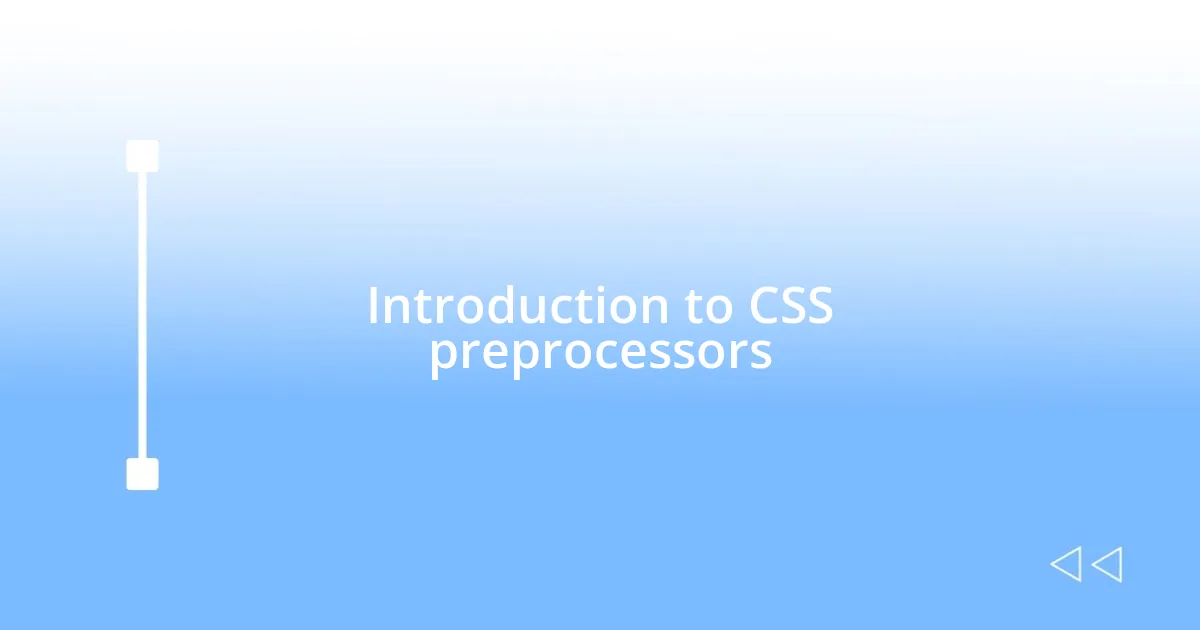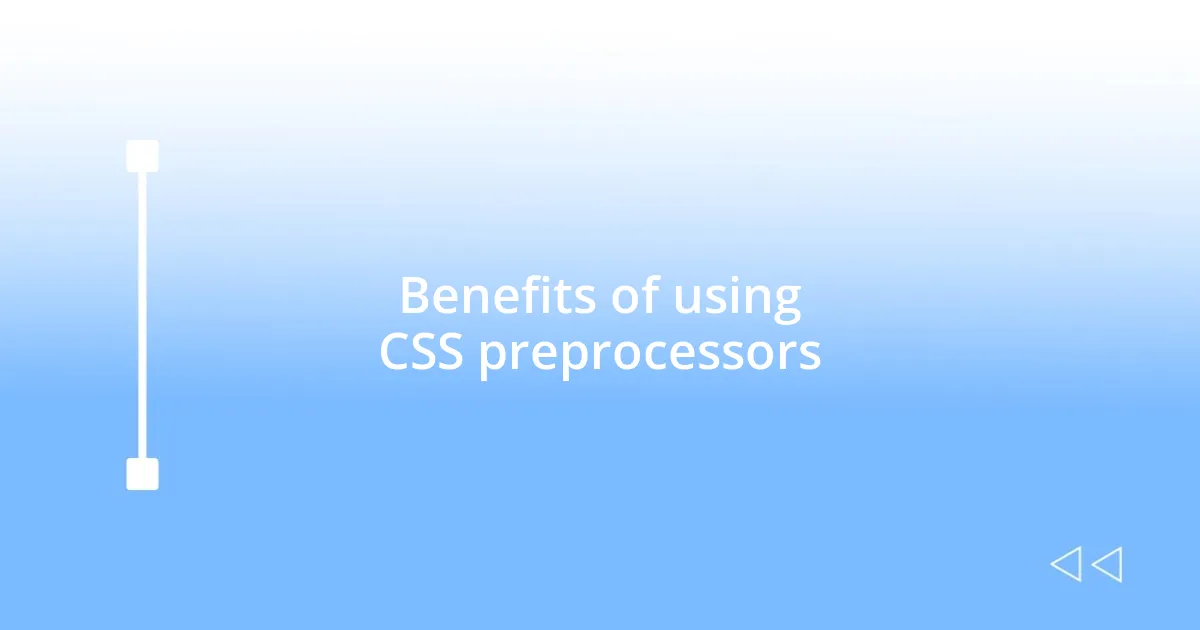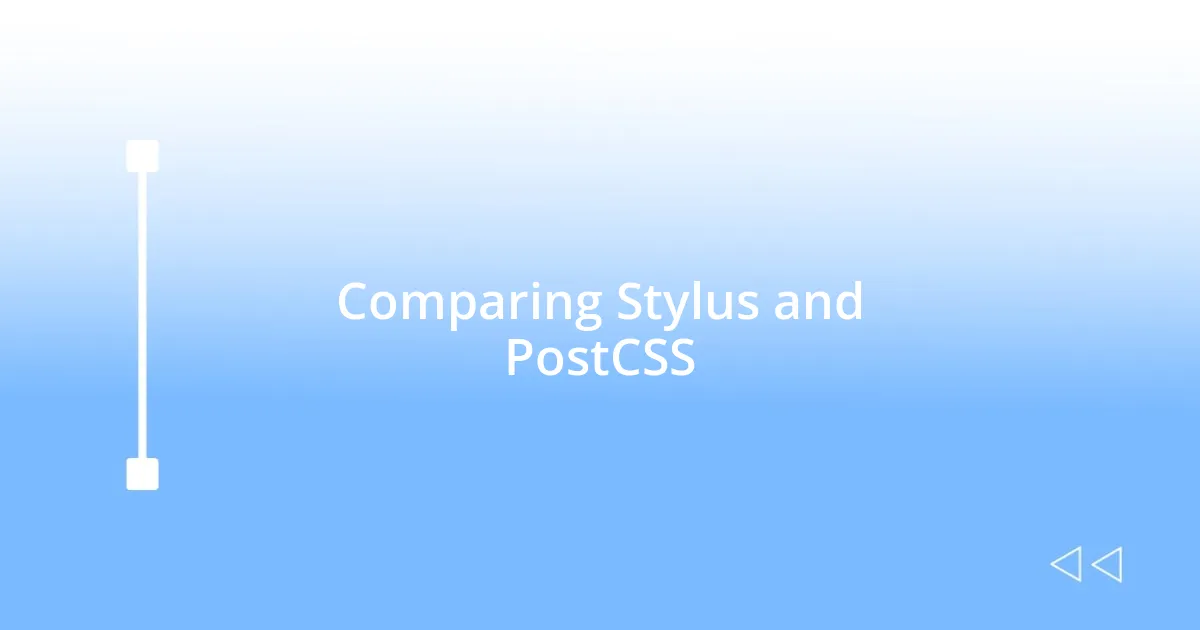Key takeaways:
- CSS preprocessors like Sass and LESS enhance CSS with features such as variables, nesting, and mixins, improving efficiency and maintainability of stylesheets.
- Sass offers advanced capabilities including control directives and inheritance, allowing for dynamic style management and cleaner code.
- LESS is favored for its simplicity and easy implementation of nesting and mixins, beneficial for straightforward projects.
- Stylus and PostCSS highlight different strengths: Stylus provides syntax flexibility, while PostCSS excels with its extensive plugin ecosystem for customizing CSS workflows.

Introduction to CSS preprocessors
CSS preprocessors are tools that extend the capabilities of traditional CSS, enabling developers to write more efficient and maintainable stylesheets. On my journey as a web developer, I found myself wrestling with the limitations of standard CSS. Have you ever noticed how cumbersome managing large stylesheets can be? It can feel overwhelming.
Preprocessors like Sass and LESS introduce features such as variables, nesting, and mixins, which can drastically enhance productivity. I remember when I first used Sass; it was like discovering a secret weapon in my coding arsenal. Suddenly, the ability to create reusable styles and make global changes became second nature, and I felt empowered to tackle more ambitious projects.
Beyond just convenience, these tools foster creativity by allowing for a more modular approach to styling. With preprocessors, I could explore design ideas quickly without getting bogged down in repetitive code. It’s almost liberating, isn’t it? As I delved deeper into the world of CSS preprocessors, I realized they not only streamline workflows but also facilitate a more organized, thoughtful approach to web design.

Benefits of using CSS preprocessors
When I first adopted CSS preprocessors, I immediately noticed their impact on my workflow. One of the most compelling benefits is the ability to use variables, which allows me to define colors or font sizes only once and reuse them throughout my stylesheets. This approach not only saves time, but it also makes maintaining and updating projects a breeze. Have you ever needed to change a color across several files? It can be a hassle, but with preprocessors, that change is swift and efficient.
Another feature that I find invaluable is nesting. It makes the structure of your styles much clearer and mirrors the HTML hierarchy, allowing you to create more intuitive styles. I distinctly remember the first time I worked on a sizable team project; using nesting made it so easy to collaborate. It instantly improved communication since everyone could quickly understand how styles related to each other. Have you experienced confusion about where to find a specific style? I know I have, and nesting is a game changer in reducing that complexity.
One major benefit that truly resonates with me is the power of mixins. These allow me to create reusable chunks of code that encapsulate specific styling. For instance, when I was designing a series of responsive buttons, I crafted a mixin that defined the button styles in one place. Using this mixin across different parts of the site was incredibly satisfying. It not only improved consistency across the design but also let me focus more on the creative aspects, rather than repetitive coding tasks.
| Benefit | Description |
|---|---|
| Variables | Define and reuse values, making updates easier and faster. |
| Nesting | Structure your styles to match HTML hierarchy for better clarity. |
| Mixins | Create reusable chunks of styles to maintain consistency and reduce redundancy. |

Overview of popular CSS preprocessors
There’s a rich variety of CSS preprocessors available today, each with its unique strengths. Throughout my coding journey, I’ve encountered several popular ones that consistently stand out. Each offers a distinct approach to enhancing CSS, allowing me to choose based on the project demands and personal preferences.
Here are a few noteworthy preprocessors:
- Sass: My personal favorite, it combines features like variables, nesting, and control directives. It feels like a full-fledged programming language.
- LESS: This one was the first preprocessor I tried, offering a simpler syntax. It’s great for projects needing straightforward features without the complexity.
- Stylus: Known for its flexibility, Stylus impressed me with its ability to allow for optional braces and semicolons, letting me write in a style that feels comfortable.
- PostCSS: While it’s a processor and not a preprocessor in the traditional sense, PostCSS allows me to transform CSS with plugins, offering extensive customization.
Each of these tools has shaped my workflow in unique ways. For instance, integrating Sass into my projects turned mundane styling tasks into an engaging creative process—like painting with a wider palette. I can vividly recall the first time I nested styles in Sass; it made me feel like I’d unlocked a level in a game. My excitement grew as I realized how organized my styles could become!

Detailed look at Sass features
One standout feature of Sass that I absolutely appreciate is the use of control directives like @if, @for, @each, and @while. These constructs allow me to implement logic in my stylesheets, enabling a more dynamic and efficient coding experience. I still remember the first time I used a loop to create a series of gradient backgrounds; it was exhilarating to see the entire project update automatically. Have you ever wanted to create a set of styles based on a specific condition? With control directives, that wish becomes effortless.
Another aspect that makes Sass a gem in my toolkit is the use of inheritance through @extend. It permits me to share styles between selectors, which saves a great deal of space in my stylesheets. I had a project where multiple buttons shared similar styles, and utilizing @extend not only made my code cleaner, but it also provided a clearer path for future adjustments. It genuinely felt like finding a hidden shortcut while navigating a complex maze!
Additionally, the functionality of built-in functions in Sass is something I can’t overlook. Functions like lighten, darken, and mix empower me to manipulate colors seamlessly. A time comes to mind when working on a branding project—I wanted to ensure the colors matched precisely the client’s vision. Using these functions allowed me to achieve that with precision, creating a cohesive and attractive design. Wouldn’t you agree that having those kinds of tools at your disposal makes the entire creative process feel more joyous?

Exploring Less advantages
The simplicity of LESS is something that consistently draws me back to it, especially when I need to tackle straightforward projects. I recall the first time I wrote my styles using LESS; seeing how easily I could define variables and apply functions made me smile. It’s like having a toolbox where the tools are perfectly arranged for quick access, allowing me to work more efficiently and with less mental clutter.
One feature I particularly enjoy in LESS is its ability to nest styles. This hierarchical organization helps me reflect the structure of my HTML, creating a clear relationship between elements. I remember working on a web app where I had to manage deeply nested elements. Using LESS to nest my CSS not only made the styles easier to read, but it also provided a huge boost in my productivity—everything felt connected, making the development process much smoother.
Another highlight of LESS is its use of mixins. They allow me to create reusable styles, which is incredibly useful when I need consistency across different elements. I vividly remember implementing a mixin for a button design that I wanted to replicate throughout the site. After a bit of initial setup, I could easily apply that style across numerous areas with just a single line of code. Wasn’t that a refreshing experience? With mixins, it’s like having a reliable friend who always lends a hand when you need a little help in your styling journey.

Comparing Stylus and PostCSS
When I dive into comparing Stylus and PostCSS, a few differences stand out. Stylus feels incredibly flexible, allowing me to ditch the braces and semicolons; it’s like writing CSS in a more artistic, free-flowing manner. I can’t help but recall a project where I embraced that freedom by crafting styles that felt less like code and more like poetry. Have you ever experienced that rush of creativity when you can write code that flows effortlessly?
On the other hand, PostCSS resonates with me due to its plugin architecture. What I find fascinating is the vast ecosystem of plugins that allow me to customize my CSS workflow. I once needed to automatically add vendor prefixes and realized how simple it was with PostCSS. The fact that I could extend the functionality quickly with a few plugins transformed my file preprocessing experience, almost like adding spices to a dish—it made everything pop even more!
One of the intricacies of each preprocessor lies in Stylus‘s syntax flexibility versus PostCSS‘s reliance on structured CSS. While I often thrive in the inventiveness of Stylus, there are times when I appreciate the clarity of sticking to CSS standards with PostCSS. I remember grappling with a collaborative project where my teammates preferred standardized code—using PostCSS made our collaboration seamless. Doesn’t the comfort of knowing your styles are structured while still being powerful make the coding experience so much more enjoyable?














